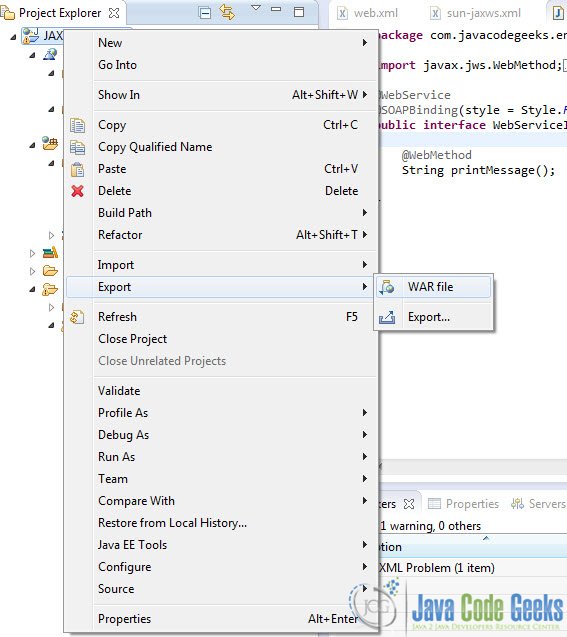JAX-WS Web Services On Tomcat
In this tutorial we are going to see how to deploy JAX-WS Web Services on Tomcat. For this tutorial we are going to use Eclipse Eclipse 4.3 Kepler, which will also help us to construct the necessary WAR file for the Web Application.
In order to deploy a Web Service on Tomcat one should follow these steps:
- Frist of all you have to download Apache Tomcat.
- Copy JAX-WS RI jars in
TOMCAT_HOME/libfolder - Create a Dynamic Web Application in Eclipse.
- Create a JAX-WS Endpoint (Web Service interface, and Web Service implementation).
- Create a
sun-jaxws.xmlto define the Web Service implemenation class. - Create a
web.xmlto describe the structure of the web project. - Export WAR file from Eclipse and copy it to
TOMCAT_HOME/webappsfolder. - Start Tomcat.
1. JAX-WS Dependencies in Tomcat
Tomcat will need some jars in order to deploy a JAX-WS Web Service. You have to go to : http://jax-ws.java.net/ and download JAX-WS RI library. Unzip the folder and copy the jars in TOMCAT_HOME/lib folder. If you don’t want to copy the complete library these are the jars that are necessary:
gmbal-api-only.jarjaxb-impl.jarjaxws-api.jarjaxws-rt.jarmanagement-api.jarpolicy.jarstax-ex.jarstreambuffer.jar
2. Create a Dyncamic Web Project in Eclipse
Open Eclipse IDE and go to File -> New -> Project -> Web -> Dynamic Web Project :
Then create a Project with name JAX-WS-Tomcat.
3. Service Endpoint
In order to create our Web Service Endpoint:
- First you have to create a Web Service Endpoint Interface. This interface will contain the declerations of all the methods you want to include in the Web Service.
- Then you have to create a class that actually implements the above interface, which will be your Endpoint implementation.
Web Service Endpoint Interface
WebServiceInterface.java:
package com.javacodegeeks.enterprise.ws;
import javax.jws.WebMethod;
import javax.jws.WebService;
import javax.jws.soap.SOAPBinding;
import javax.jws.soap.SOAPBinding.Style;
@WebService
@SOAPBinding(style = Style.RPC)
public interface WebServiceInterface {
@WebMethod
String printMessage();
}Web Service Endpoint Implementation
WebServiceImpl.java:
package com.javacodegeeks.enterprise.ws;
import javax.jws.WebService;
@WebService(endpointInterface = "com.javacodegeeks.enterprise.ws.WebServiceInterface")
public class WebServiceImpl implements WebServiceInterface{
@Override
public String printMessage() {
return "Hello from Java Code Geeks Server";
}
}4. Create the web.xml file
Go to WebContent/WEB-INF folder and create a new XML file .This is a classic web.xml file to deploy a Web Service.
web.xml:
<?xml version="1.0" encoding="UTF-8"?> <!DOCTYPE web-app PUBLIC "-//Sun Microsystems, Inc.//DTD Web Application 2.3//EN" "http://java.sun.com/j2ee/dtds/web-app_2_3.dtd"> <web-app> <listener> <listener-class> com.sun.xml.ws.transport.http.servlet.WSServletContextListener </listener-class> </listener> <servlet> <servlet-name>sayhello</servlet-name> <servlet-class> com.sun.xml.ws.transport.http.servlet.WSServlet </servlet-class> <load-on-startup>1</load-on-startup> </servlet> <servlet-mapping> <servlet-name>sayhello</servlet-name> <url-pattern>/sayhello</url-pattern> </servlet-mapping> <session-config> <session-timeout>30</session-timeout> </session-config> </web-app>
5. Create sun-jaxws.xml file.
You have to define the Service Endpoint Implementation class as the endpoint of your project, along with the URL pattern of the Web Service. Go to WebContent/WEB-INF folder and create a new XML file
sun-jaxws.xml:
<?xml version="1.0" encoding="UTF-8"?> <endpoints xmlns="http://java.sun.com/xml/ns/jax-ws/ri/runtime" version="2.0"> <endpoint name="WebServiceImpl" implementation="com.javacodegeeks.enterprise.ws.WebServiceImpl" url-pattern="/sayhello" /> </endpoints>
You can find more info in the JAX-WS Documentation.
This is the Eclipse Project Structure:
6. Export WAR file
Now, go to the Package explorer and Right Click on the Project -> Export -> WAR file :
Now you have to save the WAR file:
After exporting the WAR file you have to copy it to TOMCAT_HOME/webapps folder. There are quite a few ways to create the WAR file. You can use Maven, Ant, or even the jar command line tool.
Now you can start Tomcat. Then put the following URL in your Web Browser :
http://localhost:8080/JAX-WS-Tomcat/sayhello
If everything is ok this is what you should get:
Now you can create a consumer of the Web Service like we did in previous tutorials like JAX-WS Hello World Example – RPC Style.
This was an example on how to deploy JAX-WS Web Services on Tomcat. Download the Eclipse Project of this example : JAX-WS-Tomcat.zip








Hi, thanks for this, but the JARs aren’t in the ZIP you point to on github :-(
it’s a bit late reply but perhaps it could still help you…
you need to Download standalone distribution, link is in the readme on before mentioned github link
Hi,
Instead of putting JAX-WS RI jars to ${TOMCAT_HOME}/lib, may I put them under WebContent/WEB-INF/lib? Does it work too?
sure, you can put jars in this path web-inf/lib
This was helpful though I had to hunt the jar files from maven central and other jars as needed.